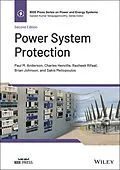A newly updated guide to the protection of power systems in the 21st century
Power System Protection, 2nd Edition combines brand new information about the technological and business developments in the field of power system protection that have occurred since the last edition was published in 1998.
The new edition includes updates on the effects of short circuits on:
* Power quality
* Multiple setting groups
* Quadrilateral distance relay characteristics
* Loadability
It also includes comprehensive information about the impacts of business changes, including deregulation, disaggregation of power systems, dependability, and security issues. Power System Protection provides the analytical basis for design, application, and setting of power system protection equipment for today's engineer. Updates from protection engineers with distinct specializations contribute to a comprehensive work covering all aspects of the field.
New regulations and new components included in modern power protection systems are discussed at length. Computer-based protection is covered in-depth, as is the impact of renewable energy systems connected to distribution and transmission systems.
Autorentext
PAUL M. ANDERSON, PhD, (deceased) served as a professor of engineering at Iowa State University, Arizona State University, and as a visiting professor at Washington State University. He also founded consulting firm Power Math Associates, and was elected to the National Academy of Engineering in 2009. Dr. Anderson passed away in 2011.
CHARLES F. HENVILLE is the President and Principal Engineer of Henville Consulting, Inc. He is a Fellow of the IEEE Power and Energy Systems Society, and past Chairman of the Power Systems Relaying Committee of the IEEE Power and Energy Systems Society.
RASHEEK RIFAAT is a Technical Director, Electrical with more than 40 years of Canadian and overseas experience with various projects, ranging from installation of control panels and 600 V MCCs for material handling systems to large 800 MW thermal generating stations.
BRIAN JOHNSON, PhD, is a University Distinguished Professor of Electrical Engineering and Schweitzer Engineering Laboratories Endowed Chair in Power Engineering. He is a Senior Member of the IEEE, and an Individual Member of CIGRE.
SAKIS MELIOPOULOS, PhD, is a Distinguished Professor at Georgia Tech. He is the co-inventor of the Smart Ground Multimeter and the Macrodyne PMU-based Harmonic Measurement System for transmission networks.
Klappentext
A newly updated guide to the protection of power systems in the 21st century
Power System Protection, 2nd Edition combines brand new information about the technological and business developments in the field of power system protection that have occurred since the last edition was published in 1998.
The new edition includes updates on the effects of short circuits on:
- Power quality
- Multiple setting groups
- Quadrilateral distance relay characteristics
- Loadability
It also includes comprehensive information about the impacts of business changes, including deregulation, disaggregation of power systems, dependability, and security issues. Power System Protection provides the analytical basis for design, application, and setting of power system protection equipment for today's engineer. Updates from protection engineers with distinct specializations contribute to a comprehensive work covering all aspects of the field.
New regulations and new components included in modern power protection systems are discussed at length. Computer-based protection is covered in-depth, as is the impact of renewable energy systems connected to distribution and transmission systems.
Inhalt
Author Biographies xxv
Preface to the Second Edition xxvii
List of Symbols xxix
Part I Protective Devices and Controls 1
1 Introduction 3
1.1 Power System Protection 3
1.2 Prevention and Control of System Failure 3
1.3 Protective System Design Considerations 8
1.4 Definitions Used in System Protection 9
1.5 System Disturbances 11
1.6 Book Contents 12
Problems 14
References 15
2 Protection Measurements and Controls 17
2.1 Graphic Symbols and Device Identification 17
2.2 Typical Relay Connections 19
2.3 Circuit Breaker Control Circuits 22
2.4 Instrument Transformers 23
2.5 Relay Control Configurations 37
2.6 Optical Communications 38
Problems 42
References 44
3 Protective Device Characteristics 47
3.1 Introduction 47
3.2 Fuse Characteristics 48
3.3 Relay Characteristics 61
3.4 Power Circuit Breakers 87
3.5 Automatic Circuit Reclosers 93
3.6 Automatic Line Sectionalizers 98
3.7 Circuit Switchers 100
3.8 Digital Fault Recorders 101
Problems 103
References 103
4 Relay Logic 109
4.1 Introduction 109
4.2 Electromechanical Relay Logic 110
4.3 Electronic Logic Circuits 111
4.4 Analog Relay Logic 125
4.5 Digital Relay Logic 128
4.6 Hybrid Relay Logic 139
4.7 Relays as Comparators 140
Problems 153
References 157
5 System Characteristics 163
5.1 Power System Faults 163
5.2 Station Arrangements 176
5.3 Overhead Line Impedances 182
5.4 Computation of Available Fault Current 184
5.5 System Equivalent for Protection Studies 188
5.6 The Compensation Theorem 202
5.7 Compensation Applications in Fault Studies 205
Problems 210
References 214
Part II Protection Concepts 215
6 Fault Protection of Radial Lines 217
6.1 Radial Distribution Systems 217
6.2 Radial Distribution Coordination 219
6.3 Radial Line Fault Current Calculations 222
6.4 Radial System Protective Strategy 233
6.5 Coordination of Protective Devices 236
6.6 Relay Coordination on Radial Lines 241
6.7 Coordinating Protective Devices Measuring Different Parameters 258
Problems 269
References 276
7 Introduction to Transmission Protection 277
7.1 Introduction 277
7.2 Protection with Overcurrent Relays 278
7.3 Distance Protection of Lines 285
7.4 Unit Protection 299
7.5 Ground Fault Protection 301
7.6 Summary 310
Problems 311
References 315
8 Complex Loci in the Z and Y Planes 317
8.1 The Inverse Z Transformation 317
8.2 Line and Circle Mapping 320
8.3 The Complex Equation of a Line 327
8.4 The Complex Equation of a Circle 328
8.5 Inversion of an Arbitrary Admittance 330
8.6 Inversion of a Straight Line Through (1, 0) 333
8.7 Inversion of an Arbitrary Straight Line 335
8.8 Inversion of a Circle with Center at (1, 0) 336
8.9 Inversion of an Arbitrary Circle 338
8.10 Summary of Line and Circle Inversions 340
8.11 Angle Preservation in Conformal Mapping 341
8.12 Orthogonal Trajectories 342
8.13 Impedance at the Relay 346
Problems 348
References 350
9 Impedance at th...
